34 Migratory Ducks You Need to Know About
Did you know that nearly half of all bird species on Earth migrate at some point during the year? Ducks are no exception. Whether it’s a quick seasonal hop to a nearby wetland or a daring journey across continents, many ducks take flight to find warmer weather, better food, or safe nesting grounds. Their travels are guided by the rhythms of nature — changing daylight, shifting temperatures, and the call of survival. Some cover thousands of miles without stopping, while others make shorter, familiar trips year after year. No matter the distance, these migratory ducks are true masters of the skies — proof that wanderlust runs deep in the feathers of the wild.
- Fully Migratory Ducks
- 1. Green-winged Teal
- 2. Falcated Duck
- 3. Common Teal (Eurasian Teal)
- 4. Eurasian Wigeon
- 5. Baikal Teal
- 6. Marbled Duck
- 7. Eastern Spot-billed Duck
- 8. Northern ‘Borealis’ Eider
- 9. Northern Pintail
- 10. Ruddy Shelduck
- 11. Gadwall
- 12. Blue-winged Teal
- 13. Smew
- 14. Fulvous Whistling Duck
- 15. Ferruginous Duck
- 16. Velvet Scoter
- 17. Surf Scoter
- 18. Common Eider
- 19. Common Shelduck
- 20. Southern Pochard
- 21. Garganey
- 22. Red-breasted Merganser
- 23. Red-crested Pochard
- 24. Cinnamon Teal
- 25. Rosy-billed Pochard
- 26. Mallard
- 27. Northern Shoveler
- 28. Redhead
- 29. Tufted Duck
- 30. Common Pochard
- Partial Migratory Ducks
Fully Migratory Ducks
The first group of migratory ducks are the fully migratory species. Almost every individual in these species travels great distances each year between their breeding and wintering grounds. Guided by instinct, they follow the rhythm of the seasons—seeking warmth, open water, and abundant food.
1. Green-winged Teal
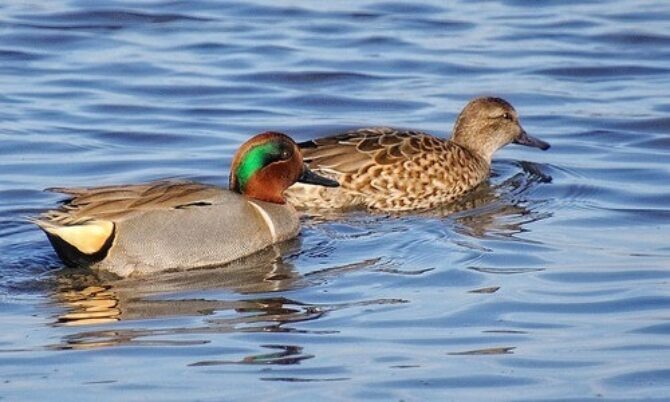
The Green-winged Teal is one of the smallest and most widespread ducks in North America — and it sure loves to travel! Every year, these tiny fliers journey from Alaska and Canada down to the southern United States and even Central America for the winter. You can often find them resting on calm lakes, marshes, and estuaries, where they gather in big, chattering flocks. They’re quick and agile in the air, but also fun to watch as they tip upside down to feed on seeds and tiny insects in the water.
2. Falcated Duck

The Falcated Duck is a real beauty — its shimmering green and bronze feathers look almost metallic in the sunlight. These ducks are strong migrants, leaving their northern breeding grounds in Russia and flying south each winter to warmer places like China, Vietnam, and India. They’re often seen in peaceful wetlands and flooded rice fields, where they rest and feed together in groups. Though their numbers have dropped in some areas, conservation efforts are helping protect their favorite wintering spots.
3. Common Teal (Eurasian Teal)

The Common Teal, also known as the Eurasian Teal, is one of the most abundant ducks in Europe and Asia. When autumn arrives and northern lakes freeze, they migrate south in huge flocks to find warmer wetlands. They love to mix with other small ducks, creating lively, colorful groups on ponds and marshes. Despite their small size, these teals are tough travelers, flying long distances each year to chase the seasons.
4. Eurasian Wigeon

The Eurasian Wigeon is a sociable duck known for its gentle whistling call. As winter approaches, these birds head south from northern Europe and Asia to warmer areas where lakes and rivers stay open. They often feed in large flocks on grassy shorelines and shallow waters — sometimes alongside other ducks and geese. Watching hundreds of Wigeons grazing together on a winter wetland is a sight every birdwatcher remembers.
5. Baikal Teal
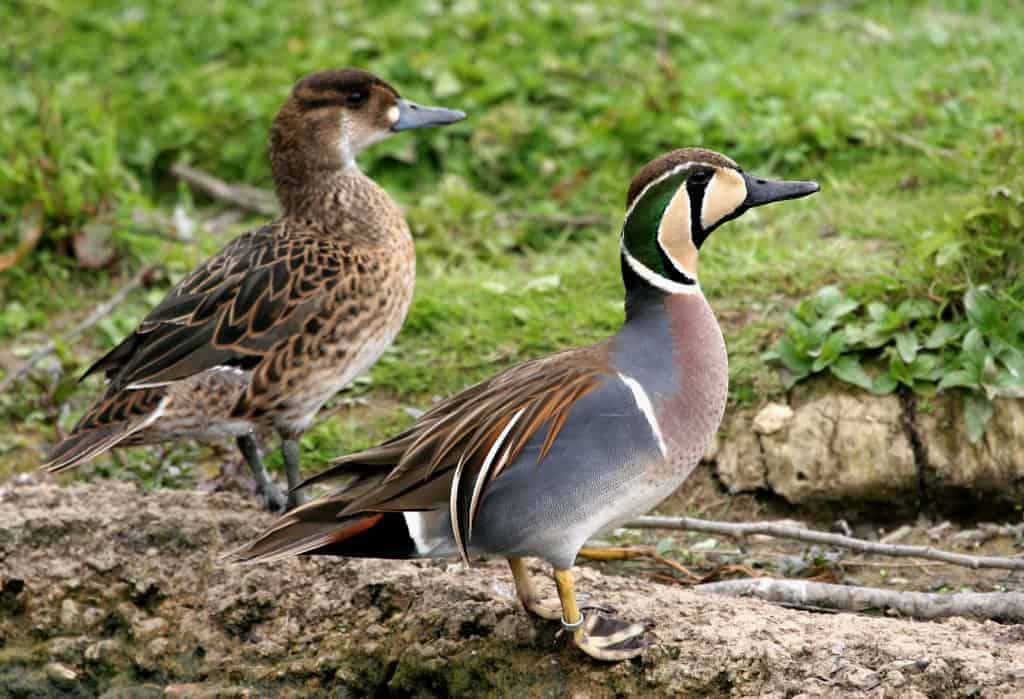
The Baikal Teal is a true traveler from the wilds of Siberia. Each autumn, thousands of them take off for East Asia’s milder lowlands, spending the winter in places like South Korea and Japan. They gather in spectacular flocks that can fill entire wetlands with motion and sound. Their colorful faces and neat patterns make them easy to spot. Thankfully, conservation work has helped their numbers rise again after years of decline.
6. Marbled Duck
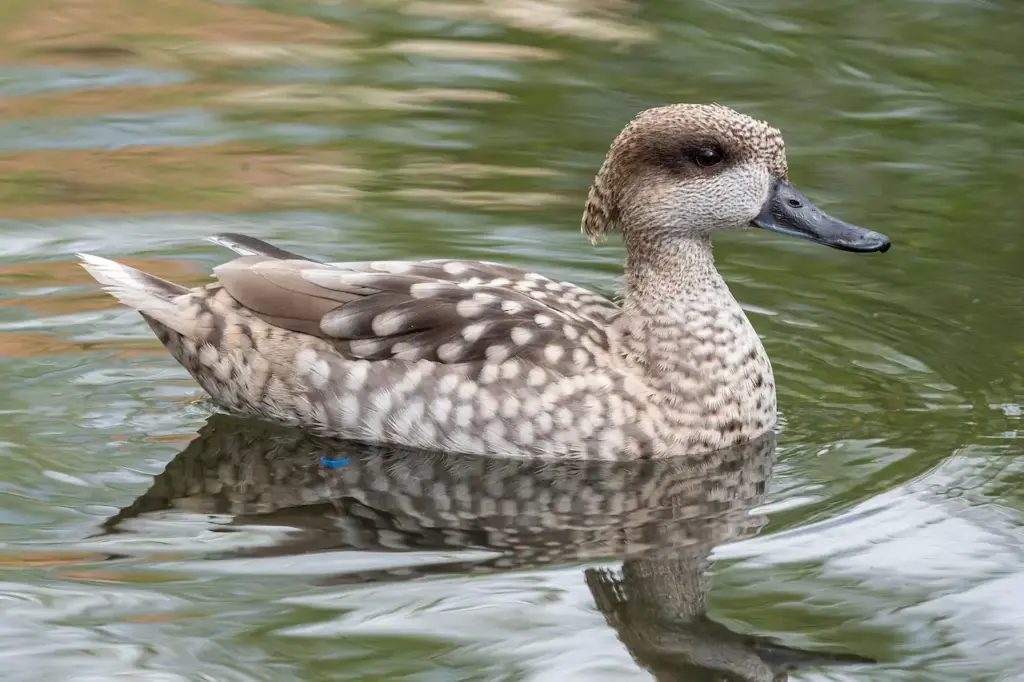
The Marbled Duck is a gentle, soft-colored bird with a beautiful speckled pattern that helps it blend into quiet wetlands. Some of these ducks migrate south in winter, traveling as far as the Sahel region below the Sahara Desert. Others stay closer to home, depending on water levels. They love calm, shallow lakes with plenty of reeds for cover. Sadly, their wetland homes are disappearing, but ongoing efforts to protect these areas are giving the Marbled Duck a better chance to thrive.
7. Eastern Spot-billed Duck

The Eastern Spot-billed Duck is a calm and graceful bird, easily recognized by the little yellow spot at the tip of its bill. In northern parts of its range, these ducks migrate south when winter sets in, heading toward the warmer wetlands of southern China and Southeast Asia. During this season, they become more social, gathering in small, friendly flocks on lakes and rice fields. They feed mostly on seeds, aquatic plants, and insects, often dabbling quietly in shallow water.
8. Northern ‘Borealis’ Eider
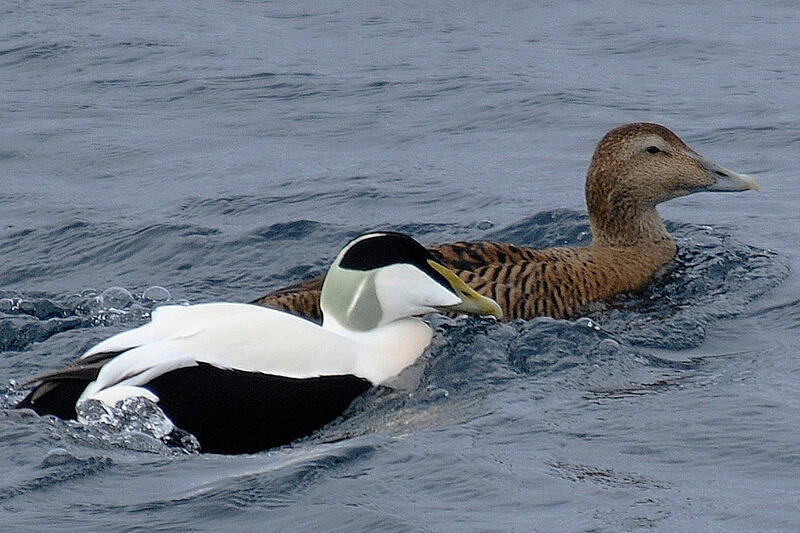
The Northern ‘Borealis’ Eider is a hardy sea duck that loves the cold — truly a bird of the Arctic! It breeds across the northern coasts of Canada, Greenland, Iceland, and Svalbard, nesting close to rocky shores and islands. When the icy winds return, these ducks migrate south to milder coastal waters, forming dense, spectacular flocks that bob together along temperate shorelines. Every so often, one of these northern wanderers is spotted much farther south in places like the Northern Isles or even Northern Ireland.
9. Northern Pintail
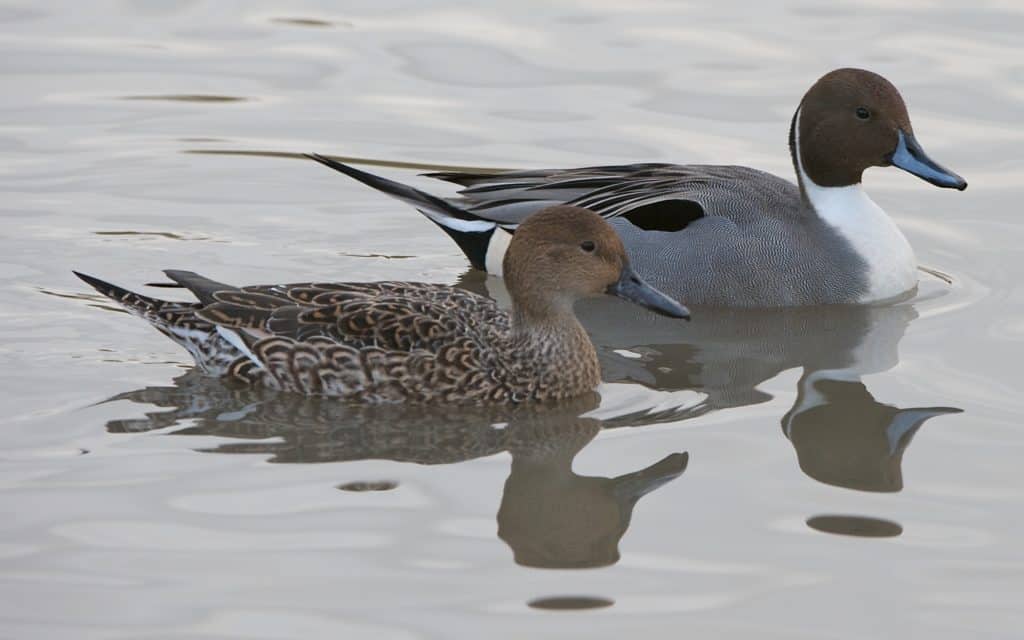
The Northern Pintail is one of the most elegant ducks you’ll ever see, with its long, slender neck and pointed tail feathers. Found across Europe, Asia, and North America, this duck breeds in the northern wetlands and tundra, then flies thousands of miles south each winter — some even reach Africa or Central America! Pintails love open wetlands and rice fields where they can feed on seeds and small aquatic creatures.
10. Ruddy Shelduck

The Ruddy Shelduck is a striking, orange-brown duck that stands out against any landscape. Migratory flocks leave their breeding grounds in Central Asia and move south in winter to India, the Middle East, and parts of Africa, where they gather in large groups along lakes and rivers. Some populations, like those in Moscow or the Canary Islands, have settled in permanently and no longer migrate. Known for their loud, honking calls and loyal pair bonds, Ruddy Shelducks are both beautiful and bold.
11. Gadwall
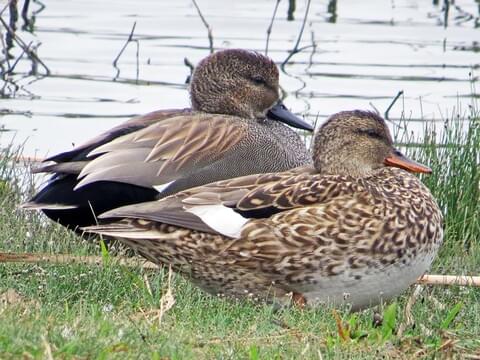
At first glance, the Gadwall might look like a plain gray-brown duck — but look closer, and you’ll see its fine, detailed feather patterns and neat white wing patch. This clever species breeds in northern wetlands and travels south each winter to warmer regions in North America, Europe, and Asia. They prefer calm lakes, marshes, and ponds where they quietly feed on aquatic plants. Gadwalls are often found in mixed flocks, blending in among other ducks but always displaying a calm, confident presence.
12. Blue-winged Teal

The Blue-winged Teal is a small, lively duck that’s always on the move — one of the earliest migrants to head south in autumn and the last to return north in spring. They travel great distances, wintering as far away as Central and South America. When they’re not migrating, these ducks love shallow ponds and marshes, where they feed on insects and seeds. Their powder-blue wing patches flash brightly in flight, making them easy to spot — a true delight for anyone who enjoys watching the changing seasons bring new flocks to town.
13. Smew

The Smew is a small, striking duck that looks like it’s dressed for winter — the male’s white body with fine black lines gives it a frosty, elegant look. It breeds across the northern forests of Europe and Siberia, often nesting in tree holes near lakes and rivers. When the cold sets in, Smews head south, gathering on unfrozen lakes and coastal waters in places like the Baltic Sea, Japan, and even Great Britain. Every now and then, a few adventurous Smews show up as far away as North America or North Africa, thrilling birdwatchers who are lucky enough to spot them.
14. Fulvous Whistling Duck
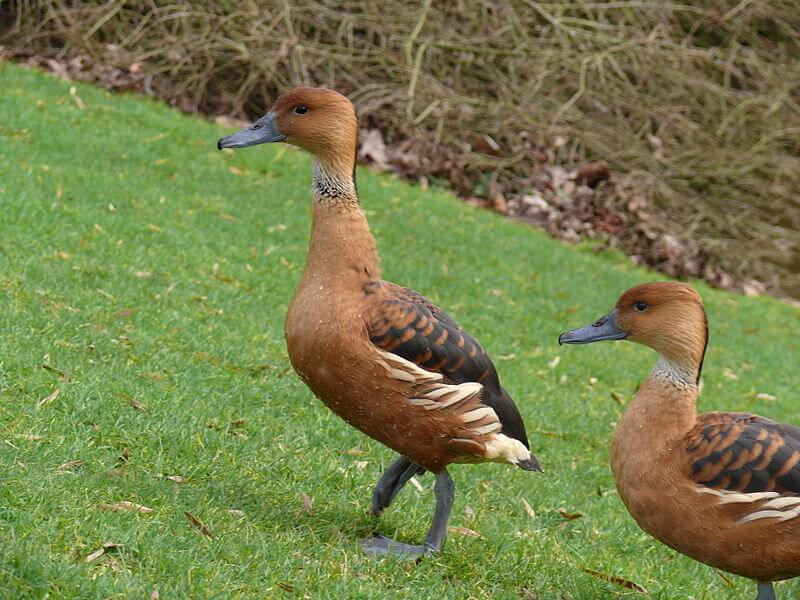
The Fulvous Whistling Duck is a tall, long-legged duck with warm, chestnut-brown feathers and a cheerful, whistling call — you can usually hear it before you see it! These ducks live in tropical regions across the Americas, Africa, and South Asia, moving with the rains to find fresh wetlands filled with food. They love rice fields, shallow lakes, and marshes, where they feed on seeds and aquatic plants. Interestingly, they’ve spread even more thanks to rice farming, especially in the U.S. Gulf Coast and Caribbean.
15. Ferruginous Duck

The Ferruginous Duck, with its rich chestnut color and bright white underparts, is a real beauty on the water. It breeds across Europe and western Asia, nesting in quiet lakes surrounded by reeds. When winter comes, it flies south to warmer spots — from the Mediterranean and Black Sea to parts of Africa and South Asia. Sadly, its numbers have declined in some regions due to habitat loss, but conservation groups are working hard to protect the wetlands it depends on. It’s a shy, gentle duck, but one that rewards patient birdwatchers with its graceful presence.
16. Velvet Scoter
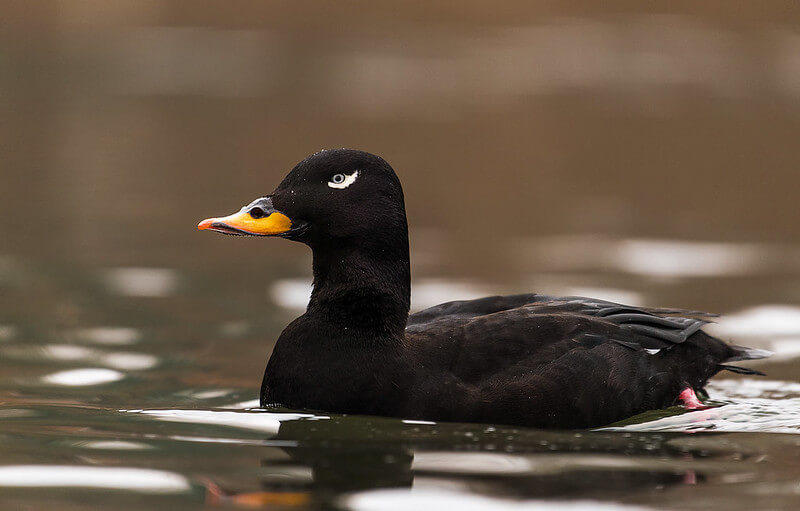
The Velvet Scoter is a strong, sea-loving duck with glossy dark feathers and a hint of white on its wings. These birds breed in northern Europe and western Siberia, nesting near freshwater lakes far from people. As the cold tightens its grip, they migrate south to milder coastal waters — around Britain, the Baltic Sea, and the Black Sea — where they gather in tight flocks that bob and dive for shellfish. They’re quiet and sturdy birds, perfectly adapted for life on rough winter seas. A close look in sunlight reveals the “velvet” sheen that gives them their name.
17. Surf Scoter
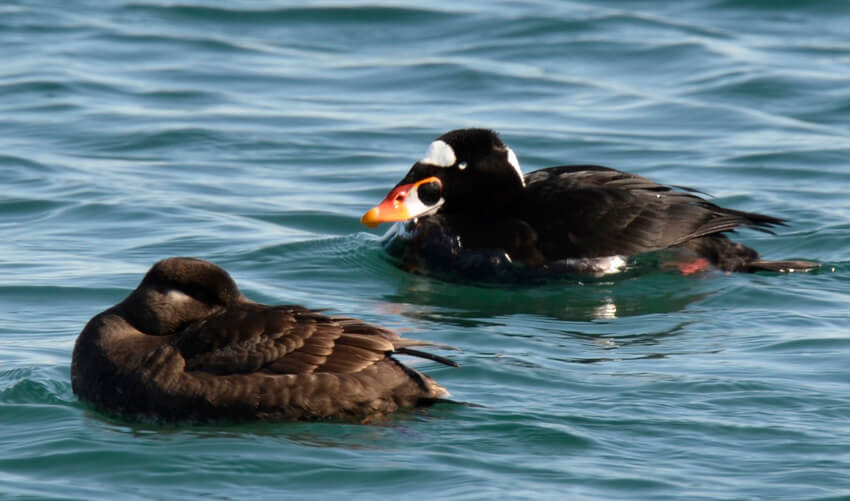
The Surf Scoter is a bold, black-and-white sea duck that loves the waves. It breeds in the wild north — places like Alaska and northern Canada — near freshwater lakes in the tundra. Once breeding season ends, it heads south to spend winter along North America’s coasts, from Alaska down to Mexico. These ducks form large flocks in bays and estuaries, diving for mussels and clams beneath the surf. Sometimes, small groups even cross the Atlantic to Europe.
18. Common Eider

Few ducks are as tough — or as stunning — as the Common Eider. These large sea ducks breed along the icy Arctic and sub-Arctic coasts of North America, Europe, and Siberia. Their soft, warm down feathers are so famous that people have used them for centuries to fill coats and bedding. When winter arrives, eiders gather in massive flocks on temperate coasts, diving for shellfish in cold, choppy waters. There are six subspecies, each with slightly different colors and bill shapes, but all share the same hardy spirit that makes them perfectly suited to life in the north.
19. Common Shelduck

The Common Shelduck stands out with its crisp white, chestnut, and black plumage — it’s one of those birds that makes you stop and stare. Many migrate to warmer places like North Africa during winter, while others in western Europe stay put, gathering in large groups on estuaries and tidal flats. These ducks love wide, open shorelines where they can probe the mud for snails and insects. When the tide is low, you might see hundreds feeding together, their bright colors shining in the winter sun.
20. Southern Pochard

If you travel through Africa or South America and spot a dark, glossy duck paddling calmly through a marsh or farm dam, it’s likely a Southern Pochard. These adaptable birds love shallow waters rich with aquatic plants. Once, they migrated more widely, but today many have become homebodies thanks to man-made water bodies like reservoirs and dams. They’re strong divers and often feed underwater, using their sharp bills to snip vegetation. Southern Pochards are quiet and rather shy, but they play an important role in keeping wetlands healthy.
21. Garganey
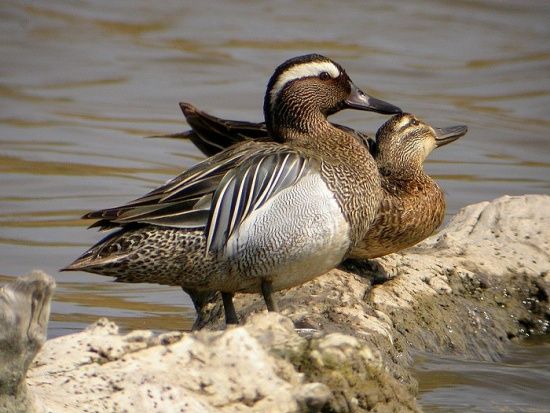
The Garganey is a true world traveler. Every year, these small ducks embark on a long, impressive journey from Europe and Asia all the way to Africa and South Asia to escape the cold. Unlike many ducks, they are entirely migratory — none stay behind when winter comes! They prefer shallow wetlands full of reeds and insects, where they can feed and rest before heading north again to breed in spring. Spotting a Garganey during migration season always feels like meeting a little adventurer passing through on a grand journey.
22. Red-breasted Merganser

The Red-breasted Merganser is a sleek, fish-eating duck with a spiky crest and a long, narrow bill built for catching prey. It breeds in the cooler regions of North America, Europe, and Asia, nesting near lakes and rivers in the far north. As temperatures drop, it moves south to coastal waters, becoming one of the few mergansers that truly loves saltwater. Some populations in places like Britain and Iceland stay year-round, braving the cold with ease.
23. Red-crested Pochard
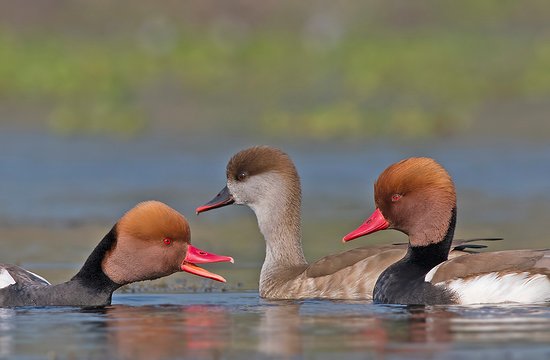
Elegant and striking, the Red-crested Pochard is easy to recognize — especially the males, with their bright orange heads and deep red bills. After breeding, these ducks head south, arriving at wintering lakes and lagoons from October onward. They prefer calm waters with plenty of vegetation for food and cover. In milder parts of southern Europe, some flocks decide not to migrate at all, taking advantage of the gentle climate and abundant food to stay put year-round.
24. Cinnamon Teal

The Cinnamon Teal adds a splash of warm color to any wetland it visits. After breeding in North America, these ducks head south for the winter, some traveling all the way to South America. They’re especially fond of shallow, food-rich wetlands where they can dabble for seeds and aquatic insects. Populations in the western U.S. sometimes remain in place if winters are mild, while others join the great southward migration.
25. Rosy-billed Pochard
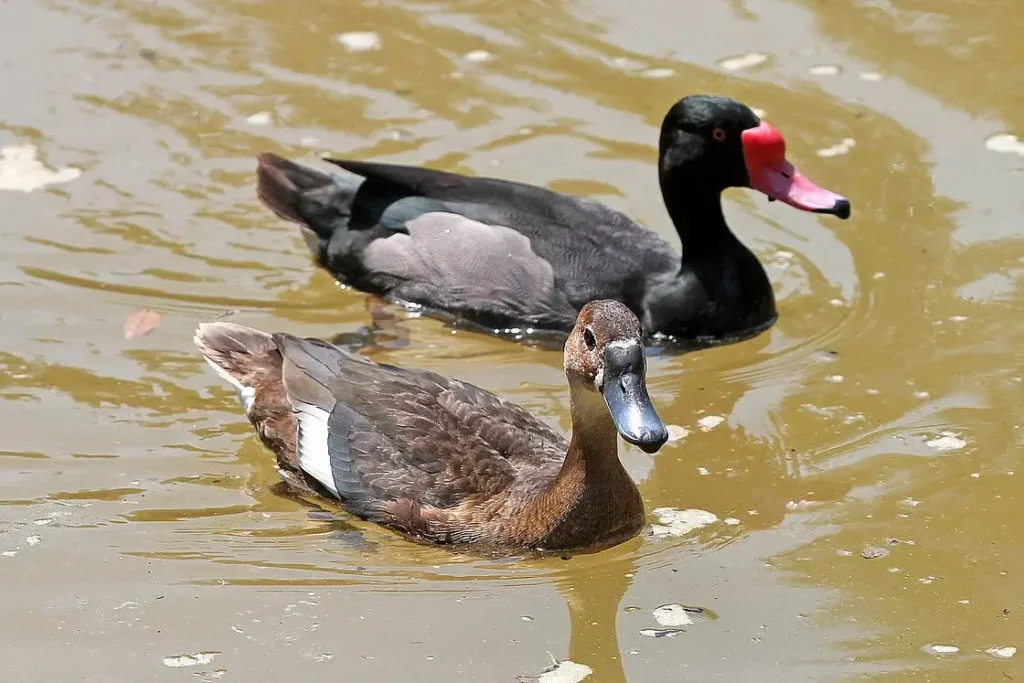
The Rosy-billed Pochard, with its distinctive pink-red bill and dark plumage, is one of South America’s most beautiful diving ducks. These birds are fully migratory, moving northward during the southern winter when wetlands dry up. They gather in impressive flocks wherever water and vegetation are plentiful. Populations can rise dramatically in wet years when temporary lagoons form across the grasslands, providing rich feeding grounds. Adaptable and resilient, Rosybills are a familiar sight in both natural marshes and human-made ponds.
26. Mallard
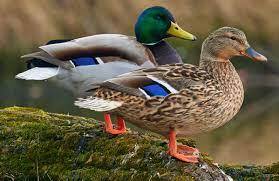
Arguably the world’s best-known duck, the Mallard thrives on nearly every continent. It’s the ancestor of most domestic ducks and an expert at adapting to all sorts of habitats — from city parks to Arctic tundra. In northern regions, Mallards migrate south as lakes freeze, while in milder climates, many remain all year. Their familiar “quack” and green-headed males make them easy to recognize, whether in a quiet village pond or a crowded winter wetland full of travelers.
27. Northern Shoveler

Northern Shovelers are famous for their oversized, spoon-shaped bills — perfect for filtering small crustaceans and seeds from the water. After breeding in the northern hemisphere, they head south to warmer wetlands and estuaries, sometimes covering vast distances. Many spend winter south of the Himalayas, in Africa, or around the Mediterranean. Along the way, they stop at key wetlands to rest and refuel. Watching a flock of shovelers sweep their bills side-to-side in unison across a lagoon is one of nature’s quiet spectacles.
28. Redhead

Redheads are graceful diving ducks known for the males’ rich chestnut heads and blue-gray bills. When winter sets in, they journey south to warmer areas where lakes and wetlands stay unfrozen. The Gulf Coast — especially Texas, Louisiana, and Florida — becomes home to huge flocks that gather to feed and rest. Redheads often mix with other diving ducks like canvasbacks and scaups, creating lively, colorful groups on the water. Their diet mainly includes aquatic plants and seeds, though they’ll sometimes nibble on small invertebrates for extra energy.
29. Tufted Duck

Easily recognized by the little tuft curling from the back of its head, the Tufted Duck is a familiar sight across Europe and Asia. These ducks migrate south as northern lakes freeze, forming impressive winter flocks on ice-free lakes, reservoirs, and sheltered coasts. In milder places like the British Isles, many stay put all year. Tufted Ducks are strong divers, feeding mainly on mollusks and aquatic plants.
30. Common Pochard

The Common Pochard is a handsome diving duck, with males showing a chestnut head, black breast, and gray body. These ducks are long-distance travelers, breeding across northern and temperate Europe and Asia before flying south each autumn — often under cover of darkness. They winter on large lakes and coastal lagoons from the British Isles to the Mediterranean and southern Asia. Occasionally, a few adventurous individuals even turn up in North America. Although still widespread, conservationists are keeping a close eye on the species as wetland loss and hunting pressure have caused numbers to decline in parts of its range.
Partial Migratory Ducks
The next group includes ducks that aren’t fully migratory like the previous ones but instead fall into a category known as partially migratory. In these species, some populations or individuals migrate, while others stay put all year long.
This difference usually depends on climate, food supply, and habitat conditions. In warmer regions where water stays open and food remains easy to find, ducks have no reason to travel far. But in colder places, where lakes and wetlands freeze during winter, members of the same species may take flight and head south in search of open water and abundant feeding grounds.
31. Black-headed Duck

The Black-headed Duck is a fascinating species from South America, known for being the world’s only parasitic duck—it lays its eggs in the nests of other birds! Most populations stay put throughout the year, especially where wetlands stay full. However, some groups in Paraguay and parts of Bolivia are more mobile, appearing mainly outside the breeding season when water levels and food conditions are better.
32. Lake Duck

You’ll often find the Lake Duck gliding across freshwater lakes and marshes thick with reeds and aquatic plants. These stiff-tailed ducks are partially migratory, shifting locally in search of suitable wetlands when water levels change. Their powerful diving ability helps them feed deep underwater, where they hunt for insects and aquatic vegetation.
33. Red Shoveler
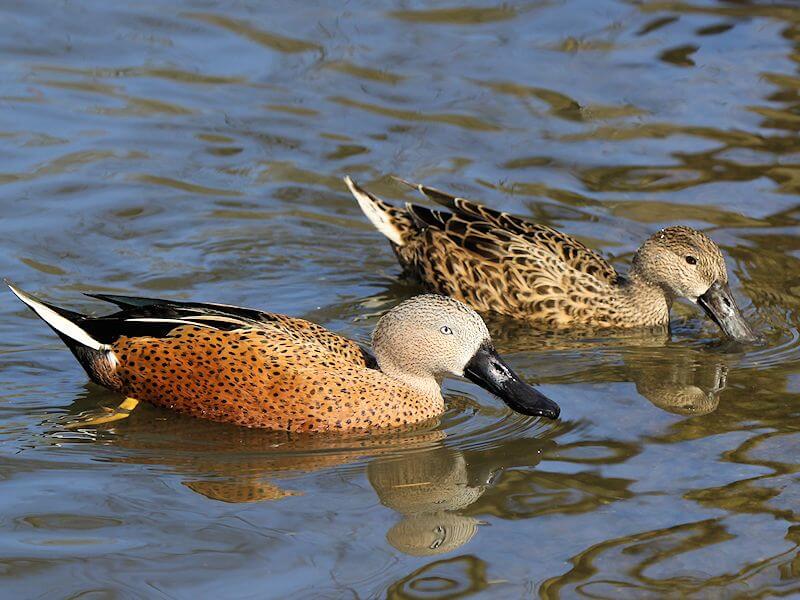
The Red Shoveler, with its rosy-brown plumage and broad bill, is a common sight in southern South America’s shallow lakes and lagoons. While many stay in one place all year, birds from the far south move northward during winter to avoid harsh weather. They feed by filtering small invertebrates and plant matter through their large, spoon-shaped bills—a feeding method that always impresses birdwatchers.
34. Common Merganser
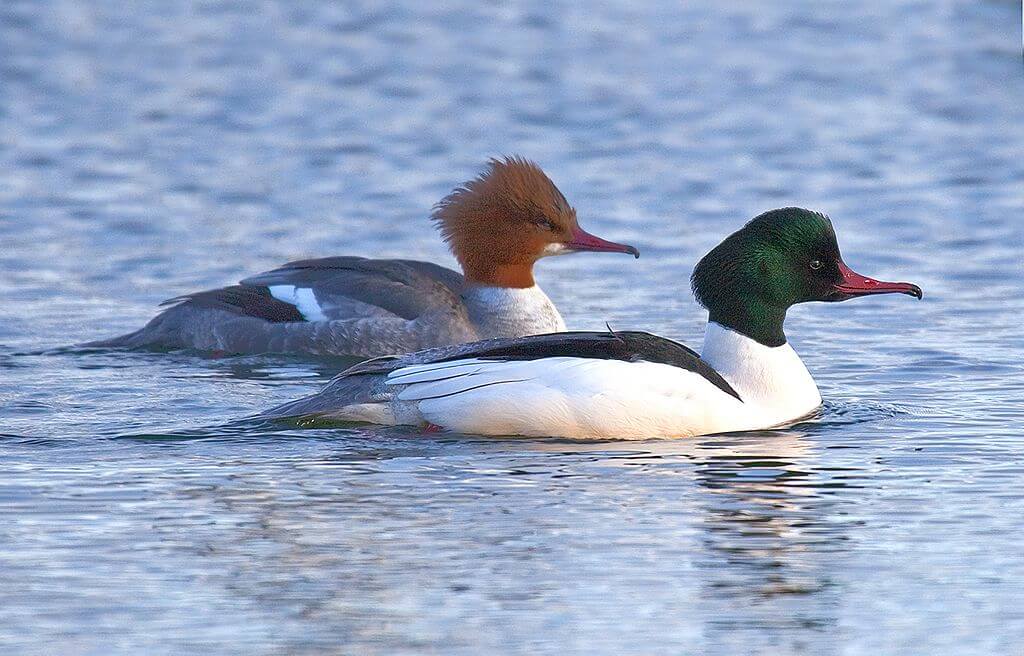
Finally, the Common Mergansers, or “goosanders,” are sleek, fish-eating ducks often seen along clear rivers and forested lakes. They’re partially migratory, leaving areas that freeze over in winter but staying put where water remains open. In Europe, Scandinavian and Russian populations head south, while western birds often remain local. Interestingly, males sometimes migrate early to coastal estuaries to moult, leaving females behind to raise the ducklings—one of the many quirks that make mergansers such captivating birds to observe.
